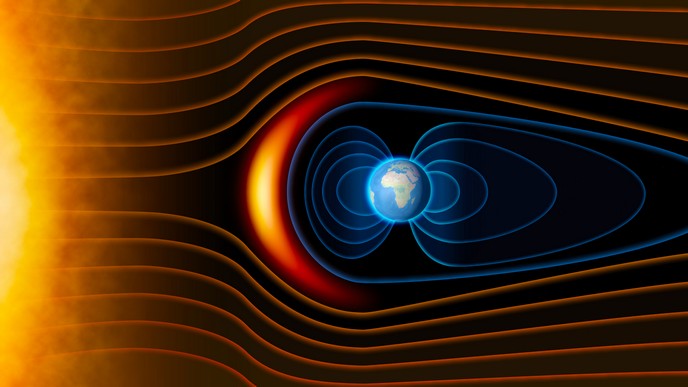New study uncovers the behaviour of cosmic rays in the Heliosphere
First discovered in 1912 by physicist Victor Hess after a high-altitude balloon flight, cosmic rays are constantly bombarding the Earth’s atmosphere, producing showers of secondary particles that even sometimes reach the Earth surface. Cosmic rays are mainly made up of high-energy particles such as protons or electrons. Thanks to detailed and continuous measurements of cosmic rays, researchers can now see that the cosmic-ray flux changes over relatively short timescales. Gone with the solar wind When travelling inside the Heliosphere – a bubble-like region of space dominated by the Sun, which also contains the solar system – cosmic rays are deflected and decelerated by the turbulent magnetic fields of the Sun and by the outflowing solar wind. These built-in shields provided by the Sun decrease the flux of cosmic rays that reaches Earth. “This shield is not stationary though. Instead, it changes periodically with the 11-year change in the Sun’s magnetic activity cycle. The visible change of the cosmic-ray flux with Sun’s magnetic activity is known as solar modulation of the cosmic-ray flux at Earth,” notes Prof. Bruna Bertucci, who has been in charge of the EU-funded Marie Skłodowska-Curie Individual Fellowships grant called project MAtISSE. Researchers modelled solar modulation to better understand the process by which the Sun’s changing activity influences the cosmic-ray flux that reaches Earth. Skirting limitations Researchers have poured time and effort to establish a general framework to interpret different types of data that are usually analysed in physics separately. “We believe that progress in the field of solar modulation relies crucially on merging expertise from different fields. Different field activities include direct measurements on high-energy particles collected in space, counting rates from ground-based neutron monitors, and observations of the Sun’s magnetic activity operated by space probes or solar observatories,” emphasises Prof. Bertucci. For a long time, the study of solar modulation has been limited by the scarcity of cosmic-ray data. “Nowadays, the Alpha Magnetic Spectrometer (AMS) – a particle physics experiment module that is mounted on the International Space Station – which has been listening for cosmic-ray strikes over the past seven years – offers researchers the opportunity to make substantial advances in the field,” notes Prof. Bertucci. The data from the AMS is highly valued because they accurately measure the behaviour of all different cosmic ray species over a wide energy interval and along an extended time period; prior to its installation, researchers had to rely on data sets of few particle species with higher error rates, limited either in energy or in time or both. Complex time-dependent behaviours In collaboration with researchers working on the AMS, MAtISSE has contributed to the measurement of the temporal variations of the proton, helium, electron and positron fluxes in cosmic rays. Researchers have reported that the proton and helium flux densities that reach Earth every month increase when solar activity is low – just like after the solar maximum that occurred in 2014. If results are seen on a yearly timescale, the ratio between proton and helium fluxes shows a remarkable long-term relationship. This puzzling behaviour reflects fundamental properties of the cosmic-ray transport in the Heliosphere and is now under further investigation. Protection against cosmic rays By modelling basic transport processes in the Heliosphere, the team explored the time lag between the solar activity changes and the corresponding changes in the cosmic-ray flux measured in Space. They compared the outputs of their cosmic-ray modulation model to the large collection of observations of cosmic-ray proton fluxes over time. This helped them demonstrate that the best fit to data occurs with an eight month lag between the solar cycle and the cosmic-ray flux variation. Project findings are very important as knowledge of the current solar activity could allow us to accurately predict the solar modulation that will occur eight months from now. “In crewed missions, the exposure to the cosmic radiation represents an important risk factor that has to be quantitatively addressed. If this model is correct, it will enable us to plan safer interplanetary space missions in the future,” notes Prof. Bertucci.
Keywords
MAtISSE, cosmic rays, cosmic-ray flux, solar modulation, Heliosphere, Alpha Magnetic Spectrometer (AMS), solar activity, solar wind, high-energy astrophysics, solar science




